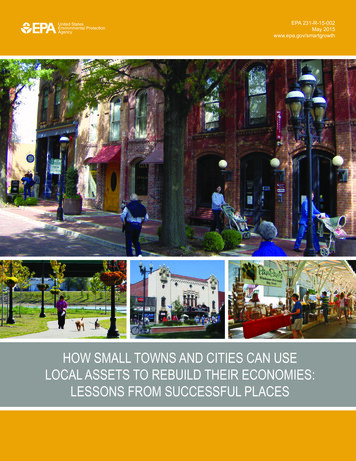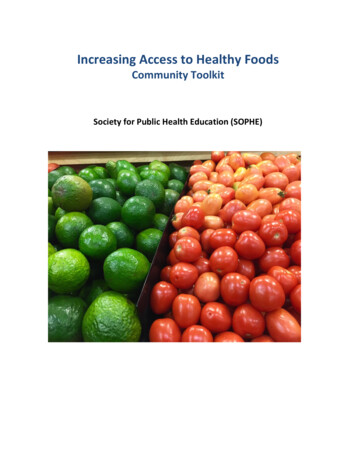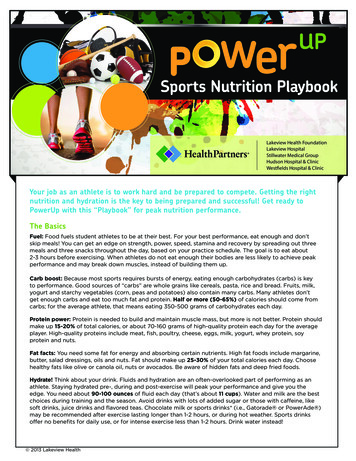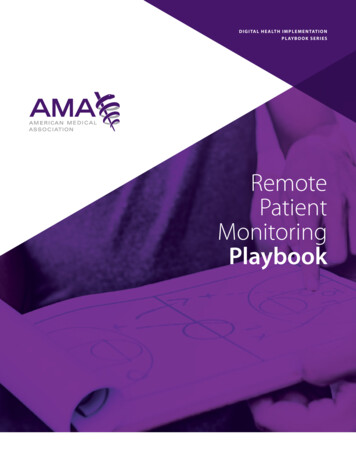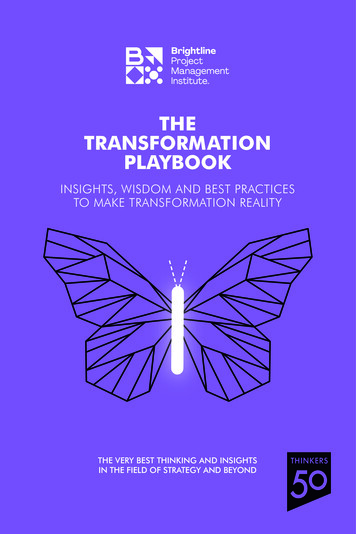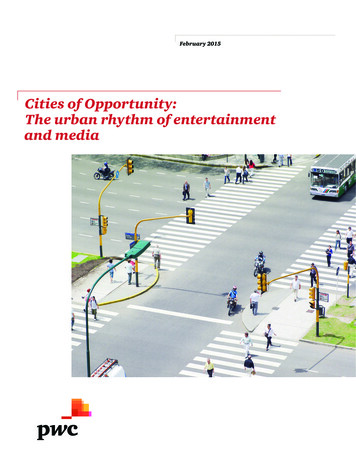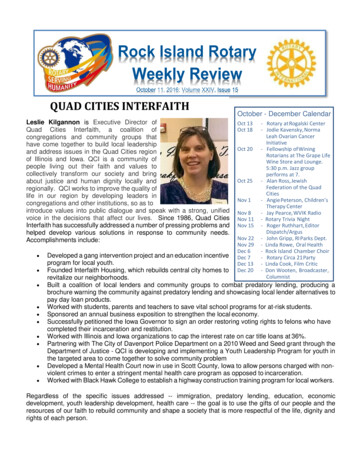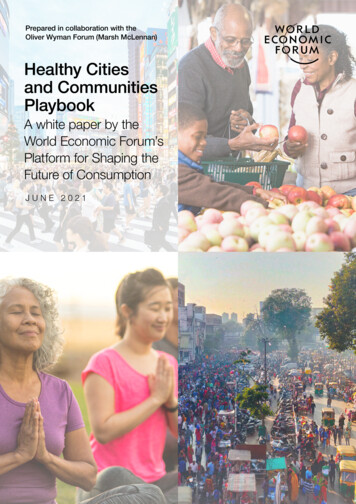
Transcription
Prepared in collaboration with theOliver Wyman Forum (Marsh McLennan)Healthy Citiesand CommunitiesPlaybookA white paper by theWorld Economic Forum’sPlatform for Shaping theFuture of ConsumptionJUNE 2021
Cover: Albachiaraa, Getty Images; PeopleImages, Getty Images; FatCamera, Getty ImagesInside: Getty Images, UnsplashContents3Preface4Executive summary61 Introduction72 Forces shaping urban health and well-being93 Envisioning holistic health and well-being in cities144 Stakeholders’ Toolkit: Capability development175 City Pathways to healthy living226 Going forward23Contributors24Acknowledgements26Endnotes 2021 World Economic Forum. All rightsreserved. No part of this publication maybe reproduced or transmitted in any formor by any means, including photocopyingand recording, or by any informationstorage and retrieval system.Healthy Cities and Communities Playbook2
June 2021Healthy Cities and Communities PlaybookPrefaceZara IngilizianHead of Consumer Industriesand Platform for Shapingthe Future of Consumption,World Economic ForumMore than half of the world’s population live inurban areas. However, cities often struggle withprioritizing agendas to ensure the physical andmental well-being of their citizens where they live,work, shop and play. In light of COVID-19, the needto empower consumers – preventatively – to leadhealthy lives is critical because non-communicablediseases are rising faster in cities than elsewhere.City governments cannot solve this challenge aloneand need leadership from business, civil societyand academia.We believe that with a collaborative approach, citieshave the potential to be centres of innovation andprogress. They can empower consumers to achievean improved state of physical and mental wellbeing through positive lifestyle choices in their localenvironments. We believe healthy living is no longera choice; it is an imperative.In this context, to build a resilient future for allstakeholders, the World Economic Forum’sPlatform for Shaping the Future of ConsumptionMayuri GhoshHead of Healthy Cities andCommunities, Platformfor Shaping the Futureof Consumption, WorldEconomic Forumaims to forge responsible models of consumptionthat are equitable, promote societal well-beingand protect the planet. Improving consumer wellbeing, a key transformation goal of the platform,is even more relevant for a post-COVID era toensure positive benefits for business and society.To advance the goal, the platform’s Healthy Citiesand Communities initiative is a flagship effortdriving public-private action in partner cities forbetter health and well-being outcomes.To scale efforts across more cities, this HealthyCities and Communities Playbook, developed incollaboration with the Oliver Wyman Forum (MMC),serves as a key guide for the implementation ofpartnerships in cities. The project team would liketo extend its appreciation and gratitude to all of theparties who have played a major role in developingthis playbook.We are confident that our collective efforts will enablepeople to lead longer, fuller and healthier lives.Healthy Cities and Communities Playbook3
Executive summaryMaintaining health and well-being is the issueshaping our time. It is the existential challengeof living in the modern world, a challenge thatconfronts every individual consumer in the face ofthe numerous pressures and strains of urban life.For instance, our built landscape contains manyfood deserts, where healthy dietary choices aresimply not available to many living in our cities.Young people all too often have poor mental healthand are offered little support.Around the world, in every city, poor lifestylechoices, limited opportunities and inadequatefinancial security have combined to produce poornutrition, insufficient physical activity and limitedrest. The outcome of such unhealthy living is seenin rising levels of obesity, diabetes, high bloodpressure and high cholesterol levels – the rootcauses of many preventable diseases.The World Economic Forum’s Healthy Cities andCommunities initiative, launched in September2019, aims to improve people’s well-beingholistically by enabling them to live longer and fullerThe assessment integrates choices determinedbroadly by city environments and by society atlarge, along with those that are almost solelyindividual choices.The holistic framework has been reinforced withlessons learned from the Healthy Cities andCommunities Pilots run in three global – and verydifferent – cities over the past two years: JerseyCity and Austin in the United States, and Mumbaiin India. Valuable experience from the three citieshas been combined with information derived fromlives in their local environments. The initiative isproactively advancing public-private partnershipsthat empower consumers to achieve an enhancedstate of physical and mental well-being throughpositive lifestyle choices. This Healthy Cities andCommunities Playbook is a key deliverable of theoverall initiative, intended to address the currentgap in knowledge and experience at the city level toimprove health and well-being.The playbook’s objective is to provide city leaderswith a toolkit and a roadmap so that they can begintheir journey of creating, accelerating and sustaininghealthy-living environments in their cities.The playbook draws from the Healthy Cities andCommunities initiative’s definition of health andwell-being using eight interrelated dimensions ofholistic health and well-being: nutrition, sanitation,physical activity, rest, emotional resilience,spirituality, environmental and social well-being,and occupational and financial well-being. Together,these eight dimensions form the basis for assessingthe current health of any city’s population.interviews with senior leaders of 35 organizations, tocome to one major conclusion: cities alone cannottake forward this opportunity for healthy living.Partnerships involving all relevant stakeholdergroups – business, government, non-profits andacademia – are essential. All four stakeholdergroups have indispensable roles given their uniquecapabilities, which when combined create a verypowerful force to activate, sustain, replicate andscale the public-private partnerships needed topromote healthy living.Healthy Cities and Communities Playbook4
The insights from the pilots and interviews havebeen strengthened by robust secondary researchinto healthy-living activities in more than 100 citiesaround the world, diverse in terms of geographiclocation, climatic conditions, socioeconomic status,population and demographics and cultures.Collectively, the extensive research and experienceon the ground have resulted in the three tools thatform the heart of this playbook – the Healthy-LivingFramework, the Stakeholders’ Toolkit for capabilitydevelopment, and the City Pathways for publicprivate partnerships.The Healthy-Living Framework is designed to helpcity stakeholders assess their city in terms of thedifferent dimensions of healthy living. This metricsbased framework helps gauge the current state ofeach health and well-being dimension through oneor more readily available city-level indicators. Theframework forms the basis for prioritizing relevantprogrammes in local communities to match themost pressing needs.The Stakeholders’ Toolkit unpacks successful citypartnerships, identifying what each of the differentoperators – government bodies, private companies,non-profits and academic institutions – can bringto the mix. The aim of the toolkit is to identify thestrengths and capabilities that each stakeholder canbring to the partnership in order to maximize thesynergy of potential collaboration in promoting healthyliving. The toolkit is reinforced with a brief examinationof the basic principles underpinning city collaborations.The final tool of the playbook focuses on the city’spartnership journey. The City Pathways frameworkis based on cities’ differing states of readiness forpartnership, providing three broad pathways tocollaboration in healthy living. The three pathwaysresult from extensive research and analysis ofcities representing varying levels of economic,political and cultural significance. Each of thethree pathways is defined by the resources andcapabilities available to the city – the city’s “state ofreadiness” – and how this is likely to shape the cityjourney in terms of three very different models ofpublic-private partnership. The framework will helpcity leaders locate their starting point, understandthe challenges they face and prioritize the actionsthey need to take to catalyse and sustain publicprivate partnerships in healthy living.The playbook is being published in the early stagesof the World Economic Forum Healthy Citiesand Communities initiative, whose ambition is tobring lessons learned and best practices from itspilot cities and the playbook to many more cities.The initiative aims to scale its efforts to multipleglobal cities through a City Peer Network. Thenetwork will not only serve to exchange knowledgeand lessons learned between cities but will alsocultivate innovative ideas for new programmesin collaboration with business, civil society andacademia that can be activated, replicated andscaled among diverse cities around the world.The initiative continues to aspire to a healthier,happier future for consumers in cities the world over.Healthy Cities and Communities Playbook5
1IntroductionGood health and well-being are two sides of thesame coin. Their connection is underlined by theWorld Health Organization: good health is “a stateof complete physical, mental and social wellbeing and not merely an absence of disease andinfirmity”. Much of today’s health burden is dueto non-communicable diseases, which currentlyaccount for 71% of all deaths worldwide.1 Poormental health is also one of the greatest challengesof our time: one in four people suffer from mental orneurological health issues at some point in their life.The economic impact of poor health and well-beingis also immense, costing the global economy morethan 1 trillion annually.2In developing and developed countries alike,shared shortcomings in lifestyle choices, such aspoor nutrition, lack of access to hygienic sanitationfacilities, insufficient physical activity, limited restand stresses at work and in the community haveall been shown to contribute to this growingburden. Too often, the focus has been on curinga given condition or ailment. Improving health andwell-being requires a very different focus, one thatmakes cure less central.The COVID-19 crisis has underlined with greatclarity the structural weaknesses in our healthsystems, especially when paired with inadequatehealthy-living mechanisms that fail to meet theneeds of the most vulnerable in society. It hashighlighted how improved consumer choicesneed to be combined with proactive communityinterventions in order to drive better health and wellbeing. The challenges are complex, so the solutionsare unlikely to be simple.The Healthy Cities and Communities initiative waslaunched in 2019 with the vision of improvingpeople’s well-being holistically by enabling them tolive longer and fuller lives in their local environments.The initiative focuses on health and well-being in ourcities, home to those who collectively represent thegrowing majority of the human population.City inhabitants are also the consumers of goodsand services in the communities where they live,work, shop and play, and improved choices at theindividual and community levels can contributedirectly to healthy living. Cities thus have a clearincentive to encourage local residents to changetheir habits and behaviours to those that fosterimproved collective health and well-being. Ascrucibles of economic growth and the nexus ofcreative and productive human activity, cities arethe chosen locus for holistic innovation in healthyliving for the initiative.This Healthy Cities and Communities Playbook,a key deliverable of the overall initiative, aims toguide private- and public-sector leaders in shapingeffective partnerships that promote healthy livingin cities. By proactively understanding the needsof local communities, prioritizing the most criticaldimensions for action, mapping the right privateand public stakeholders for collaboration andthen bringing such diverse stakeholders togetherto enable effective collective action, cities bigand small can be well positioned to empowerconsumers to achieve the enhanced state ofphysical and mental well-being needed to promotehealthy living.Healthy Cities and Communities Playbook6
2Forces shaping urbanhealth and well-beingThe health and well-being of any city’s population isinterdependent with the nutritional, environmental,macroeconomic, technological and social forcesthat shape our societies at large. This playbookbegins by focusing on the five most significantof these forces, those that are certain to have anincreasingly transformative impact on the health andwell-being of city residents.2.1 Healthy food choicesThere have been major challenges in termsof access to and affordability of healthy foodchoices. The urban hearts of many of the world’sleading cities have become “food deserts”, wherefoodstuffs of high nutritional quality are scarce and/or sold at much higher prices than products oflower nutritional value. In the US, the Departmentof Agriculture identifies 10% of the approximately65,000 census tracts in the United States asfood deserts, with 13.5 million people in theseareas having low access to sources of healthyfood.3 When combined with consumers’ poorunderstanding of better food choices, this resultsin very significant community health inequalities inmany of today’s urban environments.preventable diseases, from diabetes (1.5 milliondeaths worldwide) to respiratory diseases (4.1million deaths), atherosclerosis and heart disease(17.9 million deaths globally).4 A healthy diet is alsoneeded for a healthy brain, which further supportsmental well-being.5Food and nutrition are critical to healthy living.Good nutrition is key to preventing many of theworld’s most common ailments. Worldwide, theleading risk factors in preventable illness areelevated blood pressure, being overweight orobese and raised blood glucose. The food andlifestyle choices individuals make determine thelikelihood of their suffering from a wide range of2.2 A changing planetClimate change is radically altering the physicalworld we inhabit. Average global temperaturesare rising and rainfall levels are becoming moreunpredictable. Drought, high winds, floodingand other extreme weather events are becomingmore frequent and severe. This is resulting inan increasingly harsh physical environment thatthreatens agricultural productivity, diminishes qualityof life and creates greater uncertainty in our day-today lives, negatively affecting all aspects of humanhealth and well-being.Unsustainable resource consumption, pollution,deforestation and habitat destruction harm theglobal ecosystem. The interconnected nature ofthe human biome and the global ecosystem ensurethese changes will produce further challengesto human health and well-being, including theemergence of new infectious diseases andreduced resilience.Healthy Cities and Communities Playbook7
2.3 Increasing urbanizationDisruptions to traditional rural livelihoods as aresult of the changing physical environment andthe promise of better economic opportunities inurban areas are driving high levels of rural-to-urbanmigration globally.6 More than 55% of the world’spopulation now live in cities and this percentage isexpected to increase to 68% by 2050.7The growing influx of migrants to cities around theworld propels the growth of informal settlementsin many city peripheries. Existing housing andsanitation infrastructures are being overwhelmed,forcing new residents to construct makeshifthousing in undeveloped areas that lack access toadequate nutrition and even basic city services,such as running water and sanitation. Today,nearly a billion people live in informal settlementsworldwide, and this is expected to double toroughly 2 billion people by 2050.82.4 Shifting demographicsThe global human population is ageing. By 2050,1 in 6 people will be over the age of 65, almostdoubling the proportion of 2019, when it was 1 in11.9 Due to their age, older consumers often facegreater health and well-being vulnerability thanyounger people. In parallel, changing societal normsand the erosion of community cohesion continue toeliminate traditional sources of care and support forelderly people.The current pressures on our societies result in manyyounger working adults facing significant challengesto their mental health. These pressures result fromthe fragmentation of community and the increasingdemands of daily life, including those in the workplaceand at home, and general financial insecurity.Across all age groups, there is a growing dividebetween the haves and the have-nots, betweenthe salaried and the precariat, which producesmore discontent, more instability and greaterphysical and mental health vulnerabilities. Poorlifestyle and nutritional options are exacerbated bythese disparities.2.5 Accelerating technology changeNew digital technologies are changing the fabric ofeveryday life. Digital devices and social media haveempowered consumers to make better choices,including more actively managing their own wellbeing. At the same time, consumers have becomemore vulnerable to misinformation and partisanviewpoints. This has polarized communities andincreased mistrust of experts, eroding communitysupport networks and confidence in public healthrecommendations.These five forces will continue to exacerbate preexisting, systemic vulnerabilities, while creatingentirely new challenges to healthy living.city level, a positive vision for healthy living can bedeveloped. The vision will prioritize and accelerateaction towards healthier living choices at acommunity and individual level. The dimensions anda framework to enable such a journey are discussedin the next sections.While an adequate response will require national/international regulatory and policy interventions tomitigate risks and negative consequences, at aDigital technologies encourage an “always-on”culture for one’s digital persona. These pressuresperpetuate long working hours and a predominatelysedentary lifestyle, producing significant challengesto mental and physical well-being.Healthy Cities and Communities Playbook8
3Envisioning holistichealth and well-beingin cities3.1 Dimensions of physical and mental healthand well-beingThe Healthy Cities and Communities initiative (andthis playbook) defines health and well-being inholistic terms that integrate factors determined byour city environments and society at large, as wellas those that are largely individual choices. Thegreat advantage of this approach is that it createsa full picture of the built environment, showing howindividuals and communities function within it interms of their health and well-being.01The visualization below is created from eightinterrelated dimensions that encompass the totalityof physical and mental well-being. Each dimensionis examined in terms of the choices the citypresents to its consumers.NutritionEncourages varied diets that are calorically sufficient and rich in essential nutrients to prevent conditionssuch as obesity and diabetes02SanitationEstablishes safe water, sanitation and hygiene practices03Physical activityPromotes a non-sedentary lifestyle, with regular movement and exercise that develop physical fitness04RestEncourages regular and adequate periods of rest, relaxation and sleep05Emotional resilienceFosters the capacity to realize one’s own ability to cope with the stresses of life06SpiritualityCreates opportunities to live with meaning and purpose by enabling connectedness with oneself and others,as well as art, music, literature, nature or a power greater than oneself07Environmental and social well-beingProvides safe, supportive physical environments, green spaces and social communities that produceopportunities for exercise and improved well-being, including for life to be lived in harmony with oneself,other people and nature08Occupational and financial well-beingEnsures self-sufficiency, enabling individuals and households to earn a living and feel financially secureHealthy Cities and Communities Playbook9
These eight dimensions together create a vision forindividual well-being that can readily be projectedonto the community at the city level. Their absenceor insufficiency records inadequacy in the city’sprovision of health and well-being choices.The following section uses a simple framework toidentify opportunities for addressing health and wellbeing in the urban context.3.2 Healthy-Living FrameworkCities are extremely diverse hubs of urban living,differing from one another in population size,demographics, geography, local climatic conditions,socioeconomic development and governance,among other attributes. Nevertheless, all cities havethe opportunity to encourage holistic health andwell-being through local collaboration, regardlessof their unique circumstances. The starting pointis to assess the city in terms of the differentdimensions of healthy living and to prioritize relevantprogrammes in the context of each of these needs.The framework is illustrative alone and is notmeant to encourage cities to aspire to a particularformula of success. It is designed solely to guidedirection, since each and every city is shaped bymany factors unique to its existence and localcircumstances. The framework will help cities gaina foothold on their journey, providing them witha first glance at a holistic view of healthy living fortheir denizens, helping identify their current positionand priorities.To help a city’s stakeholders make suchassessments, this playbook has produced ametrics-based Healthy-Living Framework, as shownbelow. This gauges the current state of each healthand well-being dimension (note that emotionalresilience and spirituality are placed together in thetable) through one or more readily available city-levelindicators. Each of these factors has a profoundimpact in shaping the local health and well-beingoutcomes of the individual city.TA B L E 1The framework also assesses how uniformlydistributed each dimension is across the city usinga measure of local disparity, the Gini coefficient:Higher Gini values are associated with greatervulnerability to preventable diseases among moredisadvantaged groups. The Gini coefficients fora city are readily calculated from census tractdata wherever this is available. This also helpsflag the areas in which even more inclusivity isneeded for any programme, perhaps in specificneighbourhoods or communities within the city.Healthy Living Framework for citiesMetricsDisparityNutritionGini coefficientPrevalence of obesityPrevalence of diabetesPrevalence of substandard sanitation facilitiesSanitationPrevalence of substandard drinking waterPrevalence of substandard hygiene facilitiesPhysical activityPrevalence of inactivityRestAverage time in bed, hoursEmotional resilience/SpiritualityPrevalence of mental/substance abuse disordersEnvironmental and social well-beingAvailability of green spaceSuicide rate relative to global averageUnemployment rateOccupational andfinancial well-beingLiteracy ratePrevalence of tertiary educationThe above framework has been applied in thecontext of the three pilot cities that have engagedwith the Healthy Cities and Communities initiativein 2019–2021: Jersey City and Austin in the UnitedStates, and Mumbai in India.Some of the highlights of these active pilots areshowcased below, demonstrating practical examplesof healthy-living initiatives in action. Many of theseexamples have the potential to be replicated and scaledboth within and beyond the city, country or region.Healthy Cities and Communities Playbook10
3.3 Spotlight on pilot citiesOver the past two years, the Healthy-LivingFramework has been tested across cities of varyingsizes and then applied directly in three city pilots.Each of the cities is diverse in terms of ethnicity,demographics, scale and economics. Each hasacted as a “living lab”, incubating health andwell-being innovations, piloting interventions anddemonstrating tangible impact through improvedhealthy-living choices.In each of the three cities, city officials and otherstakeholders from the public and private sectorsused the framework to kick-start their thinkingabout the specific interventions they need to maketo promote healthy living in their city. The frameworkenabled them to select the priority areas, helpingto identify the neediest localities and communitiesfor targeting. In their role as incubators, eachJersey City, New Jersey, USA, is a city of morethan 260,000 people within the metro New YorkCity region. Its prioritization of health and well-beingunder the leadership of Mayor Steven Fulop andthe Department of Health and Human Serviceshas taken a number of forms. Through improvedaccess to better nutrition options, as well as bettersanitation and hygiene, the municipality is enhancingthe physical and mental well-being of its residents.With this innovative policy approach to publichealth, Jersey City entered into a partnershipwith AeroFarms, a pioneer tech start-up in urbanfarming. This first-of-its-kind relationship in the USis implementing municipally driven vertical farminstallations to provide local residents strugglingwith food insecurity with regular access to fresh,locally grown greens as a vehicle to improveindividual food choices. This has the potential torevolutionize the nutritional quality of the diets ofthose living in areas that display higher rates ofobesity, heart disease, diabetes and high bloodpressure. The programme currently envisionsof the cities piloted programmes in a variety ofareas. Among their pilot interventions, cities usedinnovative programmes to target access to foodand nutrition; sanitation and hygiene; emotional andsocial well-being; and occupational and financialwell-being.Each of the pilots has produced a significantnumber of lessons, notably that a city governmentneeds to convene multiple stakeholders – frombusiness to non-profits and academia – whosepartnership is essential for successful andsustainable health outcomes. These lessons havein turn contributed to the Stakeholders’ Toolkit thatforms the next section of this playbook. The toolkitoutlines what each of the actors can bring to thepartnership to enhance the effectiveness ofhealthy-living interventions.vertical farms to be located at 10 key sites in thecity and expects to deliver approximately 19,000pounds of fresh produce to residents every year,free of charge.A second notable initiative for health and hygieneis the city’s rollout of two multifunctional mobileunits or “health buses” that draw inspiration andborrow practices from successful cases in India,which the Healthy Cities and Communities initiativefacilitated. The Health Buses provide a widerange of services targeting the needs of the mostvulnerable, including its homeless and housinginsecure populations. Basic services includeshowers, washer/dryer facilities and a consultingspace for screening and testing services. Inaddition, the buses will offer counselling options tohelp improve mental health and well-being, as wellas coordinating placements with housing agencies,making these services more readily accessible toaffected populations.Healthy Cities and Communities Playbook11
Austin, Texas, USA, is a city of nearly 1 millionpeople. The Austin Healthcare Council (AHC)10was set up with support from the Mayor’s office todevelop partnerships to improve the city’s profileand performance in health and well-being. Basedon the directive of the city government, the AHCprioritized early years interventions and life skillsenhancement for the city’s vulnerable population.In one notable programme, the AHC has beenworking in partnership with the Austin Departmentof Public Health and United Way to scale theFamily Connects Texas11 programme. As part ofthis programme, a community health and wellbeing worker visits households with newborns inthe three weeks after birth to ensure that everybaby gets a healthy start in life. The programme isholistic in nature and connects infant and parentalhealth with key aspects of well-being such as goodnutrition, sleep, social connectedness, employmentand income. More than 1,600 families have beenserved in the Austin City and Travis County area,including “virtual visits” during COVID-19. In 2020alone, 800 families were reached and expansion isplanned in 2021.In a second programme, AHC, in partnership withIBM and its “SkillsBuild” digital learning platform,12is helping jobseekers and business owners learnthe skills they need to thrive in the booming localdigital and wellness industries. IBM is working witha local partner to customize the curriculum forAustin, and the programme is extremely scalable.The programme aims to give every adult in needof a job the opportunity to develop technologyand professional skills regardless of background,education or life experiences, thereby ensuringinclusivity across all socioeconomic and demographicsegments. This is part of AHC’s drive to make Austina centre for health and well-being excellence.Healthy Cities and Communities Playbook12
Mumbai, Maharashtra, India, is a sprawlingmegalopolis of more than 20 million people. The citysees innovation as key to healthy living, with a primefocus on improved hygiene and sanitation.The Additional Commissioner of the MunicipalCorporation of Greater Mumbai has engaged withthe India chapter of the Toilet Board Coalition (TBC)to help improve basic sanitation services.13 Viapartnerships, TBC is developing self-sustained,scalable business models that can bring water,sanitation and hygiene (WASH) facilities wherethey are needed most. One such business modelis Hindustan Unilever’s Suvidha initiativ
the chosen locus for holistic innovation in healthy living for the initiative. This Healthy Cities and Communities Playbook, a key deliverable of the overall initiative, aims to guide private- and public-sector leaders in shaping effective partnerships that promote healthy living

